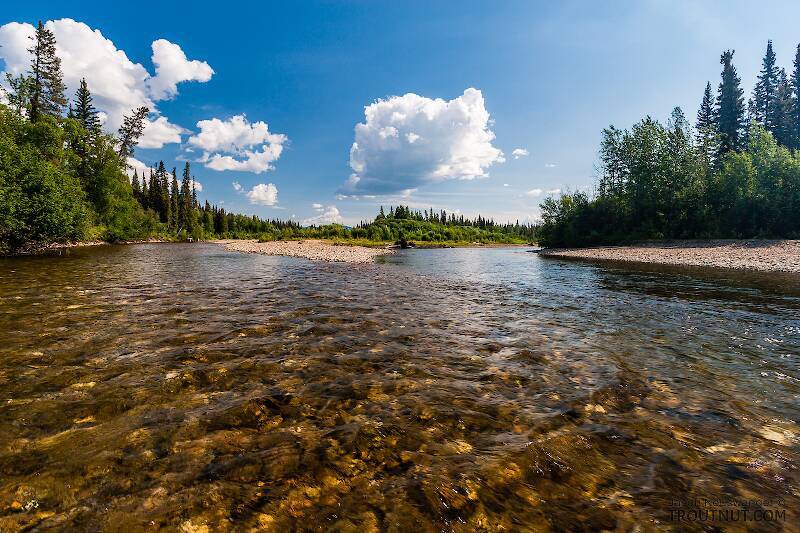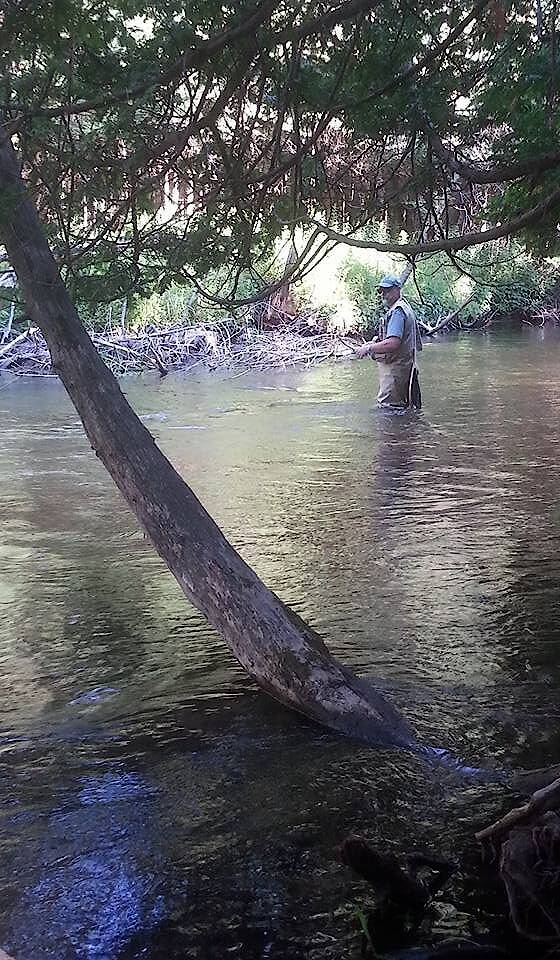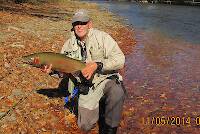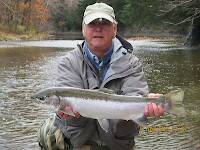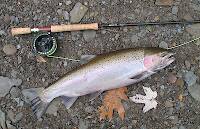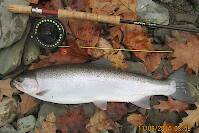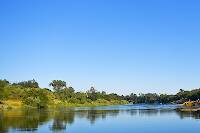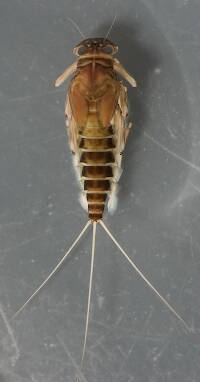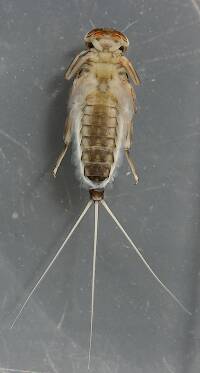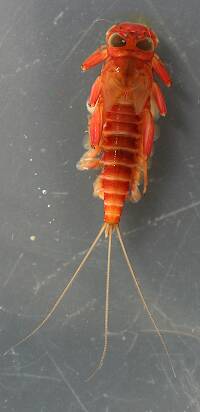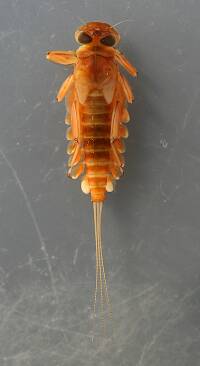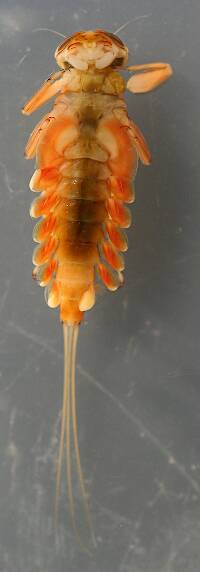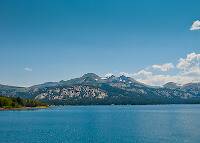
Blue-winged Olives
Baetis
Tiny Baetis mayflies are perhaps the most commonly encountered and imitated by anglers on all American trout streams due to their great abundance, widespread distribution, and trout-friendly emergence habits.
Featured on the forum

It's only barely visible in one of my pictures, but I confirmed under the microscope that this one has a prosternal horn and the antennae are mid-way between the eyes and front of the head capsule.
I'm calling this one Pycnopsyche, but it's a bit perplexing. It seems to key definitively to at least Couplet 8 of the Key to Genera of Limnephilidae Larvae. That narrows it down to three genera, and the case seems wrong for the other two. The case looks right for Pycnopsyche, and it fits one of the key characteristics: "Abdominal sternum II without chloride epithelium and abdominal segment IX with only single seta on each side of dorsal sclerite." However, the characteristic "metanotal sa1 sclerites not fused, although often contiguous" does not seem to fit well. Those sclerites sure look fused to me, although I can make out a thin groove in the touching halves in the anterior half under the microscope. Perhaps this is a regional variation.
The only species of Pycnopsyche documented in Washington state is Pycnopsyche guttifera, and the colors and markings around the head of this specimen seem to match very well a specimen of that species from Massachusetts on Bugguide. So I am placing it in that species for now.
Whatever species this is, I photographed another specimen of seemingly the same species from the same spot a couple months later.
I'm calling this one Pycnopsyche, but it's a bit perplexing. It seems to key definitively to at least Couplet 8 of the Key to Genera of Limnephilidae Larvae. That narrows it down to three genera, and the case seems wrong for the other two. The case looks right for Pycnopsyche, and it fits one of the key characteristics: "Abdominal sternum II without chloride epithelium and abdominal segment IX with only single seta on each side of dorsal sclerite." However, the characteristic "metanotal sa1 sclerites not fused, although often contiguous" does not seem to fit well. Those sclerites sure look fused to me, although I can make out a thin groove in the touching halves in the anterior half under the microscope. Perhaps this is a regional variation.
The only species of Pycnopsyche documented in Washington state is Pycnopsyche guttifera, and the colors and markings around the head of this specimen seem to match very well a specimen of that species from Massachusetts on Bugguide. So I am placing it in that species for now.
Whatever species this is, I photographed another specimen of seemingly the same species from the same spot a couple months later.

Troutnut is a project started in 2003 by salmonid ecologist Jason "Troutnut" Neuswanger to help anglers and
fly tyers unabashedly embrace the entomological side of the sport. Learn more about Troutnut or
support the project for an enhanced experience here.
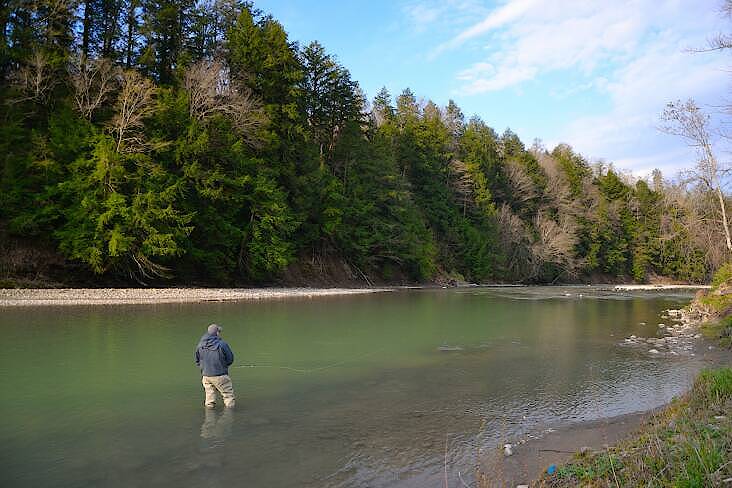
Report at a Glance
| General Region | Steelhead Alley PA & NY |
| Specific Location | Mostly Cattaraugus Creek with a little Elk Creek |
| Dates Fished | December 14 - 16 |
| Time of Day | 8:00 - dusk every day |
| Fish Caught | Steelhead |
| Conditions & Hatches | Good flow and color Monday. A very slight rain Monday afternoon totally messed up the clarity. |
Details and Discussion
Wbranch on Dec 19, 2015December 19th, 2015, 11:39 am EST
My buddy from Albany and I decided to spend the time to research places to legally park on Cattaraugus Creek in NYS. The Catt is a very long steelhead river with at least thirty miles of fish holding water from the Scoby Dam near Springville down to the mouth at Irving.
The fishing at the Catt is opposite of what it is on the PA creeks. On the PA steelhead creeks you need a significant rain event to bring up the flows and bring new fish into the river. The Catt watershed is so much bigger that the creek almost always has enough water and due to the high amounts of clay in the upper reaches of the watershed any rain at all will discolor the water to zero visibility and will pretty much ruin the fishing unless one is willing to use real single eggs or spawn sacks.
Note: There is a turbidity gage on the USGS gage site. If the turbidity is over 15 stay home as it will pretty much blown out and it takes days to get down to 15 or below.
There was just so much more water than I am used to on the PA creeks. I was able to swing a fly pretty much anywhere I wanted and was laying out 50' roll casts that on Elk Creek in PA would land the fly 20' onto the opposite bank. There were pools and glides that were 10' and more deep. There was just so much water that after the first few hours I took the 10' 6" switch rod back to the car and opted to use my 9 1/2' noodle spin rod with 8# braid and a float. With the fly rod, and the depth of most of the water we fished, I just could not safely cast far enough to get drag free floats.
We didn't hammer fish like we do on Elk Creek but most of that is because the main runs on the Catt come in October to mid November with some stragglers into December and beyond. I caught two of the smallest steelhead I have ever seen and one 24" hen. My buddy caught one about 17" and one about 22". My 24" hen fought as good as any 27" - 28" fish I've caught on Elk Creek because of the much stronger flow on the Catt. The flow was 300 cfs on Monday and 550 cfs Tuesday and Wednesday. I hooked my larger fish in a tail-out of a big pool and landed it 200' down river in a shallow riffle. I can't imagine how a 28"/10# fish would fight.
The Catt is thirty-seven miles closer to my home in York, PA but because about a third of the trip is on rural two lane roads it takes about fifteen minutes longer to get there. I'll try it again in March for drop backs and new spring fish. BTW about one half of the river below the Zoar Valley flows through the Seneca Indian Reservation. If you fish on the rez you need a special fishing permit, but don't need a NYS fishing license. If you are 65, or older, the license costs just $15.00. No lead split shot is allowed. You must use tin shot. If you are caught using lead you are in big trouble and likely will be arrested and have your tackle impounded. I think alcohol is banned from all reservation property. There is only one motel in Irving and the closest other motel is about thirty miles away.
The fishing at the Catt is opposite of what it is on the PA creeks. On the PA steelhead creeks you need a significant rain event to bring up the flows and bring new fish into the river. The Catt watershed is so much bigger that the creek almost always has enough water and due to the high amounts of clay in the upper reaches of the watershed any rain at all will discolor the water to zero visibility and will pretty much ruin the fishing unless one is willing to use real single eggs or spawn sacks.
Note: There is a turbidity gage on the USGS gage site. If the turbidity is over 15 stay home as it will pretty much blown out and it takes days to get down to 15 or below.
There was just so much more water than I am used to on the PA creeks. I was able to swing a fly pretty much anywhere I wanted and was laying out 50' roll casts that on Elk Creek in PA would land the fly 20' onto the opposite bank. There were pools and glides that were 10' and more deep. There was just so much water that after the first few hours I took the 10' 6" switch rod back to the car and opted to use my 9 1/2' noodle spin rod with 8# braid and a float. With the fly rod, and the depth of most of the water we fished, I just could not safely cast far enough to get drag free floats.
We didn't hammer fish like we do on Elk Creek but most of that is because the main runs on the Catt come in October to mid November with some stragglers into December and beyond. I caught two of the smallest steelhead I have ever seen and one 24" hen. My buddy caught one about 17" and one about 22". My 24" hen fought as good as any 27" - 28" fish I've caught on Elk Creek because of the much stronger flow on the Catt. The flow was 300 cfs on Monday and 550 cfs Tuesday and Wednesday. I hooked my larger fish in a tail-out of a big pool and landed it 200' down river in a shallow riffle. I can't imagine how a 28"/10# fish would fight.
The Catt is thirty-seven miles closer to my home in York, PA but because about a third of the trip is on rural two lane roads it takes about fifteen minutes longer to get there. I'll try it again in March for drop backs and new spring fish. BTW about one half of the river below the Zoar Valley flows through the Seneca Indian Reservation. If you fish on the rez you need a special fishing permit, but don't need a NYS fishing license. If you are 65, or older, the license costs just $15.00. No lead split shot is allowed. You must use tin shot. If you are caught using lead you are in big trouble and likely will be arrested and have your tackle impounded. I think alcohol is banned from all reservation property. There is only one motel in Irving and the closest other motel is about thirty miles away.
Catskill fly fisher for fifty-five years.
PaulRoberts on Dec 19, 2015December 19th, 2015, 2:03 pm EST
Thanks for the report and info Matt. Nice to end the season with some fish. Hey, maybe the weather will remain warm?
Roguerat on Dec 22, 2015December 22nd, 2015, 12:05 pm EST
Matt,
Nice picture, and report!
I'm curious about the bottom composition and turquoise-shaded water- I usually see this color on on a marl stream bed, although I see some rocks and stuff in the picture.
Kind of disappointing to hear the switch rod couldn't cast far enough, this has me concerned about distance with my 11' 6" switch on the Muskegon, PM, and Manistee...
Roguerat
Nice picture, and report!
I'm curious about the bottom composition and turquoise-shaded water- I usually see this color on on a marl stream bed, although I see some rocks and stuff in the picture.
Kind of disappointing to hear the switch rod couldn't cast far enough, this has me concerned about distance with my 11' 6" switch on the Muskegon, PM, and Manistee...
Roguerat
Wbranch on Dec 22, 2015December 22nd, 2015, 4:25 pm EST
Kind of disappointing to hear the switch rod couldn't cast far enough, this has me concerned about distance with my 11' 6" switch on the Muskegon, PM, and Manistee...
I should explain a bit more - I was able to roll cast close to 50' using a WF8 salt water line on the Redington 10' 6" switch rod. I just refused to go out and spend any money on a line specifically designed for my switch rod. I only use that rod a couple of times a year for swinging. I use that rod most for high stick nymphing with an indicator.
There are runs on the Cattaraugus that were just too wide, deep, and fast to get a good drift with my fly rod set-up. I have no hang-ups about using spinning tackle to enhance my catch rate in situations that are difficult with the fly rod. I'll admit it (Oh No!) that I actually like to spin with my 9' 6" light spin rod, a Plueger President reel, and 8# Berkley braid. I can throw a Sheffield float with two #3/0 split shot and a bead or whatever 70' with ease and leave the bail open to achieve 80' - 100' drag free floats. I can check the drift with my finger on the spool and when the float goes under just apply my finger to the spool and set the hook.
Catskill fly fisher for fifty-five years.
Wbranch on Dec 22, 2015December 22nd, 2015, 4:34 pm EST
The bottom of the Catt appeared to be mostly shale and typical bottom structure found on most freestone rivers. The water was what I would consider low at 325 cfs so we could see the dry river bed and it is comprised of sand, gravel, cobble, and medium to somewhat larger boulders. The upper reaches of the river flow through a section called the Zoar Valley. There are miles and miles of high clay cliffs along this section and some of the cliffs are well over 100' high. When it rains I was told large chucks of clay break off the cliffs and drop into the river. The clay breaks up and dissolves into the river giving it that emerald green color. I don't believe it ever gets really clear unless the water flow is less than 100 cfs. There is a gage on the USGS site that defines turbidity on the Catt. We were told by some fly fishers we met that good fishing can be found as long as the turbidity is no higher than 15. The first day we fished there it was 10. There was just a modest rain late Monday afternoon yet on Tuesday the turbidity was up to 50 and it can take a week for it to clear up enough to provide good fishing. I've read that about 25% of the returning steelhead are wild fish. The fish in the Catt, which is in NY and about 85 miles east of Elk Creek, average 3" - 4" bigger than the PA fish and there are far more 9# - 11# fish than are caught in the PA creeks.
Catskill fly fisher for fifty-five years.
PaulRoberts on Dec 27, 2015December 27th, 2015, 10:37 am EST
Thanks for sharing your knowledge, Matt. I'd never fished the Catt, but fished the creeks from Oak Orchard to the Salmon. I hear you on the use of mono lines and conventional tackle at times.
Quick Reply
Related Discussions
Topic
Replies
Last Reply

